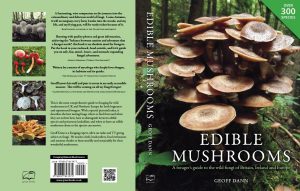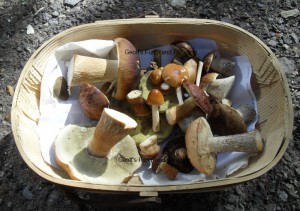Email: geoffdann@hotmail.com
Phone: 07964 569715
23/10/2016
 Firstly for anybody who doesn’t already know, my new book (Edible Mushrooms – A forager’s guide to the wild fungi of Britain, Ireland and Europe) came out last Thursday (see link at top of page). The customer reviews have already started rolling in on Amazon , if you’d like to know what some of the early buyers think of it. I’d like to thank everybody at Green Books for their hard work in the production of this book. I’m still selling signed copies for £20 (the RRP) including P&P, so email me if you’d like one.
Firstly for anybody who doesn’t already know, my new book (Edible Mushrooms – A forager’s guide to the wild fungi of Britain, Ireland and Europe) came out last Thursday (see link at top of page). The customer reviews have already started rolling in on Amazon , if you’d like to know what some of the early buyers think of it. I’d like to thank everybody at Green Books for their hard work in the production of this book. I’m still selling signed copies for £20 (the RRP) including P&P, so email me if you’d like one.
This post is mainly about things I’ve encountered while promoting the book on the internet, some of which are rather worrying. I’m not a big fan of Facebook – I’m a bit old school and prefer forums, especially because of the ability to search for historical posts and follow complex discussions. But in order to get the word out about the book, I joined a number of facebook groups related to fungi and foraging. I am very familiar with the conflict between conservationists/mycologists and foragers that has sprung up in the wake of the pro-foraging cultural change we’ve seen in Britain in recent years. I’ve spent the last five years trying to find a balanced view in the middle of it, and as a result I’ve ended up making both friends and enemies on both sides. That dispute is far from being resolved, with the recent “ban” on personal picking in the New Forest being an example of what some people in mycology and conservation want to achieve of a wider scale: the prohibition of fungi foraging. In that case the “ban” turned out to be toothless, because it is legally unenforceable, but it was a statement of intent that must not be ignored.
What I was less aware of is the level of conflict and argument that exists within the foraging world, especially on the internet. This is also partly the result of the rapidly changing culture – not long ago there simply wasn’t any foraging community in the UK – but it is also partly directly the result of the existence of the internet, which would have been a game-changer anyway, even if the British had historically foraged for fungi.
The disputes I am talking about can be broken down into four main categories.
(1) Arguments about identification and use of hallucinogenic varieties
This of least interest in the context of this blog post, apart from where it co-incides with (4) below – people picking stuff that they are hoping might be hallucinogenic species, then asking people online to identify them later. The arguments regarding the legality and ethics of the use of hallucinogenic fungi are beyond the scope of this post.
(2) Glorification of overpicking
Some people seem to think the goal of fungi foraging is to pick as much as possible of prized edible species, and then post a picture online of their “haul”. This is routinely followed by arguments about why they picked so much. The response from the picker is inevitably “There were tons; I left loads” – something which, conveniently, nobody else can verify, and which might well be true in a few cases but probably isn’t in most. Why would I say that? Because for these people, the main purpose of going foraging has ceased to be finding food and become a competitive sport. It is all about the photo at the end, of their massive “haul”, and the bigger the better. The goal has become to have taken the largest amount and post the most impressive picture, in the hope of gain kudos from other foragers. This behaviour leads to a culture where over-picking in encouraged. Even in the cases where it is actually true that loads were left, the very fact that these pictures are being posted, and the pickers congratulated, just encourages other people to go out and pick as much as possible. It incentivises picking everything, just like commercial foraging does. And perhaps more importantly, it hands ammunition to those people who want to see foraging banned. I even saw one instance of a professional foraging teacher asking what was wrong with selling any excess. The answer is that unless the landowner’s permission was sought for commercial collection, and granted, selling it would be illegal.
This is an appeal to people in the online foraging community to stop doing this. Stop turning fungi foraging into a competitive sport – stop posing with pictures of your massive “haul”, stop boasting about how many kilos of bay boletes you picked and stop encouraging other people to behave in this way. These are the people who are going to get fungi foraging banned. And I also ask other people in the foraging community – the ones who don’t do this – to condemn it whereever and whenever you see it.
(3) People confidently identifying other’s people fungi, incorrectly
This one is also about earning kudos in the online foraging community. Lots of people want to play fungi expert, it seems. In this environment, being able to identify the fungi in other people’s photos earns you respect. Unfortunately, some people either over-estimate their abilities or are knowingly “winging it”. They don’t just say “I think that might be X.” They say “X!”, giving the impression to the person who posted the photo that somebody who knows what they are doing has been able to provide a firm identification of a fungus. The potential consequences of this sort of behaviour are all too obvious – it hinders people’s learning process and may well lead to people getting poisoned.
Please do not pretend you are certain what something is unless you really are certain. Sometimes, of course, you can be certain but still be wrong, in which case be prepared to be corrected without getting upset. Many of the people whose misidentifications get pointed out by other people take it rather badly, leading to flame wars. I came across one lady last week who had incorrectly identified a Slender Parasol (Macrolepiota mastoidea) for a true Parasol (M. procera). When I pointed out her mistake and asked her to be more careful in the future for the reasons given above, she took it very personally and spent most of the rest of that evening demanding to know what my qualifications are, refusing to accept that she’d identified the fungus wrongly and telling me that she’d been taught how to forage by her Sicilian family, that her boyfriend owned a 250 acre farm in Somerset and that her husband (apparently she had both) “had a PhD in biotech”. None of which changed the fact that she’d incorrectly told somebody that a Slender Parasol was a true Parasol. The next morning, after a moderator had deleted everything she’d posted after my initial post pointing out her mistake, she continued with more of the same. She eventually told me that she was going to report me to Facebook for harrassment. Oddly enough, I’ve not heard anything from Facebook on this subject.
(4) Picking and hoping
Why bother learning to identify fungi when you can just go out and pick everything you find and post a photo on the internet accompanied by the words “which ones I can eat?” or “what sort of fungi are these?”. Not “are any of these rare?” or “how do I learn to identify these?” This behaviour is lazy, anti-social and ecologically irresponsible. It gives foraging a bad name and is another practice that hands ammunition to those who want it banned. And, predictably, many of the people who’ve posted pictures of their unidentified “haul” tend to get rather upset when instead of being congratulated, they are asked to stop behaving in an unacceptable way, leading to more flame wars. Perhaps the worst example I have ever seen of this wasn’t on a facebook group, but on my own facebook page (Geoff’s Fungi and Foraging) a few years ago. Somebody posted a photo of a kitchen sink full of water, with a large amount of fungi bobbing around in it. The person said “My wife picked these this morning in the local woods. Which ones are edible?” I didn’t quite know where to start. Firstly I could see at least one poisonous Amanita in the sink, so the whole sinkful was potentially contaminated with amatoxins (Are they water soluble? Does anybody know?). Secondly it is impossible to identify most fungi when they are bobbing around in a sink of water. Thirdly, most fungi absorb water like sponges and you shouldn’t even wash them if it can possibly be avoided, let alone drown them. And fourthly this was “pick and hope” on a grand scale, and the person responsible may well have been picking rare stuff. When I pointed all this out, the person who’d posted it got very angry, because I was “trying to make me and my wife look stupid in public.”
In summary
The British fungi foraging community needs, at this point, to be aware that we have arrived at something of a cultural crossroads. I believe it is now very likely, and possibly inevitable, that there is going to be a change in the law governing foraging. Right now we still have a chance to self-regulate within the community. We have a chance to influence the direction this culture develops in, to minimise some of the worst practices described above. If we do not then I fear that the result may well be that the those people who want to see fungi foraging prohibited may yet get exactly what they want. It is far from impossible. There are places in Continental Europe where a total ban is in place, and it could happen here.

